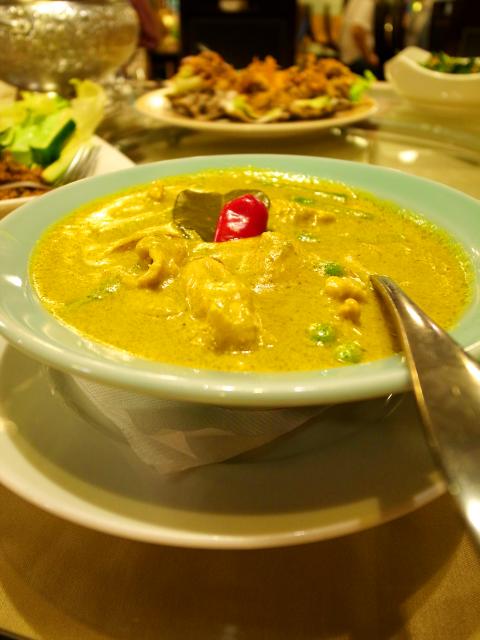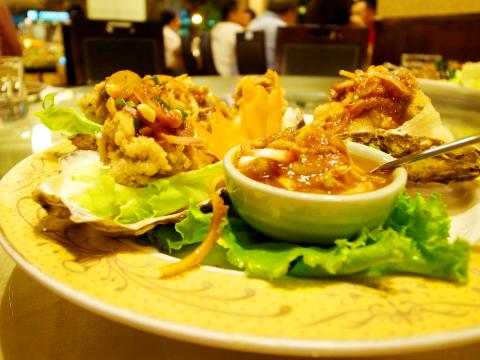Siam Kitchen looks full every time I walk pass its storefront on Anhe Road across from the Far Eastern Plaza Hotel. After two failed attempts to dine there without a reservation, I made extra effort to call ahead, and it proved worthwhile. Well-tended and staffed with a competent crew, the restaurant cooks up consistently palatable Siamese meals and should easily become one of the best bargains around the prime neighborhood.
Inside the Thai eatery, everything seems to be done in a business-focused manner. The place is spick-and-span, properly decorated but not too much to reveal a personality. Staff carry a matter-of-fact attitude; efficient, polite and largely free of emotion during our recent visit on a weekday night. A similar sense of adequacy can be detected in the food too, which is even in quality, pleasantly presented and with neither wow-inducing surprise nor disappointment.
The a la carte menu is fairly extensive, so when in doubt, go for the items listed on the chef’s recommendation page. The recommended fried oysters in hot and sour sauce (酸辣炸牡蠣, NT$380) came first and heralded a promising feast ahead. Topped with finely chopped onions, chives and garlic, the succulent shellfish was temptingly bathed in a chili-abundant, saliva-inducing pungent dressing.

Photo: Ho Yi, Taipei Times
A mellow contrast to the tangy oysters, the green curry chicken in coconut cream and sweet basil (椰汁綠咖哩雞, NT$300) saw tender white meat floating in creamy, sweet coconut milk among herbs. The fried minced pork with chili, garlic and basil (打拋豬肉, NT$300) features ground pork stir-fried with various spices and herbs to create a savory concoction that goes well with rice and beer. The latter comes in limited choices (NT$80 to NT$110), but does include the refreshing Singha Beer.
The chicken or pork satay with spicy peanut sauce (泰式沙嗲串, NT$320 for six skewers), however, received conflicting reviews among our table of six. Some liked the properly grilled meat devoid of greasiness; others believed that the barbecue should be more bold and messy in taste. Regardless, everyone agreed that the dish was well-presented, and appreciated the fact that there were not one but two accompanying sauces — creamy peanut and sweet and sour.
The climax of the evening arrived with the braised beef with massamun curry in pumpkin (咖哩南瓜牛肉, NT$380), a house specialty that was seen sitting on almost every table during our visit. Tenderly cooked and used as a bowl for the curry, the wonderfully sweet pumpkin is not only a delectable piece of cookware but offers a harmonious layer of zest and texture to the rich and creamy curry.

Photo: Ho Yi, Taipei Times
Overall, Siam Kitchen’s interpretation of Thai fare is mellow, clearly aiming for the local palate. For those who like it hot, there are several levels of spiciness to choose from. We asked for xiaola (小辣, little spicy), which is one level hotter than weila (微辣, slightly spicy). It probably partially explains the mildness of our food.
A decent selection of sweet courses are on offer and comprise traditional treats like the assorted Thai-style tapioca pearl in coconut milk (摩摩喳喳, NT$90) and glutinous rice with taro and coconut milk (芋香紫米, NT$90), as well as specialties such as the custard pumpkin (南瓜燉布丁, NT$120).
A small section of the menu is reserved for vegetarian dishes. Set menus for between three and 10 people cost from NT$460 to NT$600 per person.

Photo: Ho Yi, Taipei Times
Siam Kitchen has another venue at 39 Jilin Rd, Taipei City (台北市吉林路39號). More information can be found on the restaurant’s Web site at www.siamkitchen.com.tw.

The canonical shot of an East Asian city is a night skyline studded with towering apartment and office buildings, bright with neon and plastic signage, a landscape of energy and modernity. Another classic image is the same city seen from above, in which identical apartment towers march across the city, spilling out over nearby geography, like stylized soldiers colonizing new territory in a board game. Densely populated dynamic conurbations of money, technological innovation and convenience, it is hard to see the cities of East Asia as what they truly are: necropolises. Why is this? The East Asian development model, with

June 16 to June 22 The following flyer appeared on the streets of Hsinchu on June 12, 1895: “Taipei has already fallen to the Japanese barbarians, who have brought great misery to our land and people. We heard that the Japanese occupiers will tax our gardens, our houses, our bodies, and even our chickens, dogs, cows and pigs. They wear their hair wild, carve their teeth, tattoo their foreheads, wear strange clothes and speak a strange language. How can we be ruled by such people?” Posted by civilian militia leader Wu Tang-hsing (吳湯興), it was a call to arms to retake

This is a deeply unsettling period in Taiwan. Uncertainties are everywhere while everyone waits for a small army of other shoes to drop on nearly every front. During challenging times, interesting political changes can happen, yet all three major political parties are beset with scandals, strife and self-inflicted wounds. As the ruling party, the Democratic Progressive Party (DPP) is held accountable for not only the challenges to the party, but also the nation. Taiwan is geopolitically and economically under threat. Domestically, the administration is under siege by the opposition-controlled legislature and growing discontent with what opponents characterize as arrogant, autocratic

When Lisa, 20, laces into her ultra-high heels for her shift at a strip club in Ukraine’s Kharkiv, she knows that aside from dancing, she will have to comfort traumatized soldiers. Since Russia’s 2022 invasion, exhausted troops are the main clientele of the Flash Dancers club in the center of the northeastern city, just 20 kilometers from Russian forces. For some customers, it provides an “escape” from the war, said Valerya Zavatska — a 25-year-old law graduate who runs the club with her mother, an ex-dancer. But many are not there just for the show. They “want to talk about what hurts,” she